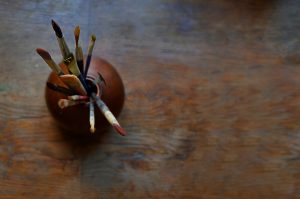Egg Tempera Painting

A Brief History of Egg Tempera Painting
Egg tempera was the primary painting medium of artists for more than a thousand years. The longevity of paintings in this medium is unparalleled. Examples of paintings from the first century still exist today with color so vibrant that they look as though they could have been painted yesterday.
The history of egg tempera painting is long and includes renaissance paintings by Bottecelli & DaVinci. In the 1500s, oils supplanted egg tempera as the primary painting medium. Oils are much slower to dry and allow for blending of colors directly on the panel or canvas. The artist can work more quickly and provides more flexibility of technique.
By contrast, egg tempera is a very fast drying medium. The paint cannot be applied thickly, but rather must be built up in many very thin layers of brush strokes. The artist must make their own paint each day because the egg binder will cause the paint to turn bad. Paintings must be done on stable panels that have been carefully and methodically prepared with traditional Gesso (animal-hide glue, usually rabbit skin, and an inert white powder, such as calcium carbonate).
Artists make the paint they need for their daily painting sessions by grinding pigment powders and distilled water with a muller. until they have a fine, consistent paste. That paste is then mixed with egg yolk and distilled water in the proper proportions. Too much egg and the paint feels greasy under the brush. Too little egg and the pigment will not bind with the panel and will eventually fall off. To complicate matters, each pigment powder has its own characteristics and the ratio of egg yolk to paste needs to be adjusted accordingly.
One might ask why I bother with egg tempera if it’s so difficult to work with. The first reason is luminosity. The egg yolk cures to perfectly clear and will never yellow the way oils do. Blacks and browns never become muddy. Colors are built up slowly in layers further enhancing the luminosity of the painting. The second reason is that I am most comfortable drawing. I was a drawing major in art school and love the slow build up of layers when working in ink, graphite, and colored pencil. Egg tempera requires the same methods as pen and ink. Hatching and cross hatching, stippling, egg tempera painting is like drawing with paint.